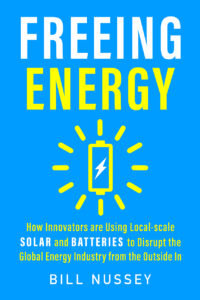
For people in the nuclear and coal industry, solar and wind probably feel like some kind of invasive species. Every effort to slow down renewables just means they pop up somewhere else. The most common complaint by traditional energy providers was echoed by my cab driver on way to the Solar conference in Vegas. He said, “without all those huge government subsidies, the solar industry would never survive.” He could have easily used another popular complaint: “the government shouldn’t use subsidies to pick favorites – it should let the market decide.” All this government support for solar just doesn’t seem fair, right?
Since Mythbusters is no longer on the air, I’ll take this one on myself.
It’s not just solar – nearly every type of energy has been subsidized at some point
Yes, it’s true that solar (and wind) enjoy large government subsidies but so does every other kind of energy! The government has been subsidizing countless nationally strategic industries for a century, including many types of energy. In fact, many experts believe that the recent boom in US “fracking” would never have happened without substantial government subsidies.
Why subsidize at all?
Subsidies and government support have played a big role in shaping commercially viable energy solutions for over a century. Subsidies spur scale and innovation, encourage investment, drive down costs by driving up volumes and, overall, make new energy technologies more viable and more affordable. The idea is that governments make investments in the form of subsidies which they hope, in turn, will produce a long tail of strategic and economic benefits to the country.
GET MONTHLY NEWS & ANALYSIS
Unsubscribe anytime. We will never sell your email or spam you.
Ever wonder why the US government uses tax breaks rather than direct grants to incentivize energy infrastructure? It turns out that, once passed by the legislature, tax breaks are locked in permanently (at least until legislatures make new laws). Grants, on the other hand, have to go through a second step of actually allocating cash to recipients. This second step opens the door for new rounds of political wrangling and raises the possibility that the promised grants may not actually come through. This kind of risk would keep businesses from investing so tax breaks are used instead to promote returns for energy investments.
How are energy subsidies allocated?
In 2013, the Congressional Budget Office[1] estimated that federal energy tax subsidies would reduce government revenue (and increase energy producer profits) by $16.4 billion that fiscal year, broken down as follows:
- Renewable energy: $7.3 billion (45 percent)
- Energy efficiency: $4.8 billion (29 percent)
- Fossil fuels: $3.2 billion (20 percent)
- Nuclear energy: $1.1 billion (7 percent)

While many types of energy are receiving subsidies, it might appear that solar is getting more than its fair share recently. However, if you pull back the lens and look over several decades, it’s clear that other types of energy have received even greater subsidies. Over the period from 1950-2010, oil and gas received roughly $490 Billion dollars in federal expenditures. By comparison, the newer technologies behind renewables received only $74 Billion over the same period[2].
Subsidies usually fade away but sometimes they become permanent
Most subsidies are designed to be short-lived – they help technologies and markets to mature and then fade away. As an example, the Business Energy Investment Tax Credit (ITC) provides a 30% tax credit for solar projects built after 2005. The 30% credit was extended in 2015 and is now scheduled to decrease down to 10% by 2021[3]. Similarly, wind projects can receive a slightly different credit called a Production Tax Credit (PTC). In this case, projects receive a tax credit over 10 years against the revenue generated by selling wind-based electricity. The PTC will decrease over the next three years and then be phased out[4].
For better or worse, not all energy subsidies fade away. The United States government lists eleven permanent fossil fuel production tax provisions alone. Combined, these provisions total $4.7 billion in annual benefit to operators of fossil energy projects[5]. For example, the depletion allowance allows owners of gas wells, oil wells, and coal mines to get tax deductions as they extract fuels from their properties. This subsidy has been in place since 1916 and is still going strong.
Government subsidies can work and some have shaped the country
It is worth recalling that several major industry sectors have deep roots in government spending programs; spending that lead to commercialization of technologies and massive economic change long after the initial government investment. For example, The Internet sector was responsible for an estimated $966.2 billion, or six percent, of real US GDP in 2014. But, it was US Department of Defense spending on ARPANET (the early version of today’s Internet) in the 1960s that got the ball rolling.
Move from the information highway to Interstate Highways for another example. Under the Federal-Aid Highway Act of 1956, the government committed to pay for 90 percent of the cost of building 41,000 miles of interstate highways. Today, more than sixty years later, that act of Congress has returned more than $6 in economic productivity for each $1 it cost.

Back to energy. The US is enjoying a renaissance in fossil fuel production largely thanks to huge innovations in hydraulic fracturing (“fracking”). Fracking was first used in 1857 but commercial success was limited to wells and rock formations with less difficult geological formations. Then, along came the energy crisis of the late 1970s and Congress passed the Crude Oil Windfall Profit Act of 1980 extending tax credits (known as Section 29) for natural gas produced from geo-pressured brine, coal seams, and Devonian shale. Fracking took off but when the credits expired in 1992 many assumed that the 562 billion cubic feet of natural gas would be the peak production. But a funny thing happened along the way. While the tax credits attracted capital investment, limited risk, and helped raise prospects for returns, they also encouraged innovation around the use of new technologies. The result was astounding. The introduction of new technologies such as 3D imaging and horizontal drilling helped improve production from the unconventional gas sources, and by 1994 production had jumped to 858 billion cubic feet of coal-bed methane gas alone! Unconventional natural gas wells made up 62% of total gas wells by 1994. Even though the Section 29 tax credit had expired, it motivated huge innovations in fracking which led to the permanent creation of competitive and mature technologies. Without Section 29, it’s entirely likely that the US would not be enjoying the huge boom in natural gas and oil these last ten years. Subsidies not only work, they can change the trajectory of the world geopolitical energy order.
It’s solar’s turn in the sun

The photovoltaic effect in solar cells was first discovered in 1839. Needless to say, commercialization didn’t happen overnight. It was over a century until the first spacecraft to use solar panels (the Vanguard 1 satellite) was launched by the US in 1958. The US government paid for the solar cells and the long march to commercialization began for clean, efficient solar energy. The space race gave solar its first nudge but it was the 50 years of additional technology improvements and the 2006 solar ITC that spurred a 3000 % growth in solar installations by 2016 Thanks in part to government incentives, private investors are pouring billions of dollars into renewable energy projects which in turn has motivated billions of dollars of investments in factory capacity and new research that will continue to grow the industry in a virtuous cycle long after the ITC expires.
Subsidies may indeed provide a leg up for newer technologies but they also have a long and beneficial tail that spurs innovation and change. So, the next time someone says that subsidies for renewable energy are unfair, just remind them that subsidies have spurred the growth of countless industries over the decades and that much of our traditional energy sources wouldn’t exist today without a lot of government help.
Special thanks to Sam Easterby whose research and prose provided the foundation for this blog.
Footnotes:
- https://www.cbo.gov/publication/43993
- http://www.misi-net.com/publications/NEI-1011.pdf
- DOE – Renewable tax credits (here)
- EPA – Production tax credits (here)
- US Treasury – tax preferences for US fossil fuel providers (here)
- EIA – Hydraulically fractured wells provide two-thirds of U.S. natural gas production (here)




One Response
This great article goes deeply into the range of fossil fuel subsidies that are artificially tipping the scale away from renewable energy: https://www.vox.com/energy-and-environment/2017/10/6/16428458/us-energy-subsidies